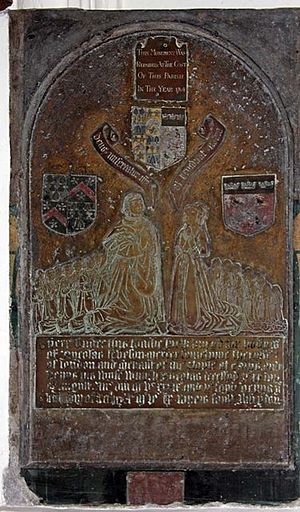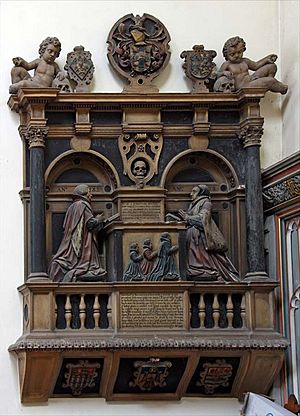Thomas Offley facts for kids
Sir Thomas Offley (born around 1500–1505, died 1582) was a very important person in London during the time of Queen Mary I of England. He served as a Sheriff of London and later became the Lord Mayor of London. Sir Thomas was also a long-time alderman, which is like a city council member. He was a leading figure in the Worshipful Company of Merchant Taylors, a group for cloth merchants, and helped start the Muscovy Company, which traded with Russia.
Contents
Early Life and Beginnings
Thomas Offley was born in Stafford, England. His father, William Offley, was a merchant who later became an alderman and Sheriff in Chester. Thomas was one of 26 children his father had, many of whom also moved to London to build their careers.
When Thomas was about 12, he moved to London. He went to St Paul's School, where he learned Latin and music. After school, he became an apprentice to John Nechylls, a successful merchant who traded wool. Thomas worked for Nechylls for 13 years.
Thomas married Joan, Nechylls's daughter, around 1530. His sister, Margaret, also married a merchant named Stephen Kirton. Many of Thomas's family members became involved in trade in London, helping each other succeed.
Becoming a City Leader
Thomas Offley became very successful in his business. In 1547, he became the Master of the Merchant Taylors' Company, a big achievement. That same year, he bought a large country estate called Madeley in Staffordshire, which became his family's home for many years. He also received a special grant of arms, like a family crest, in 1547.
Alderman and Sheriff
In 1549, Offley was chosen as an alderman for London, representing the Portsoken area. He later moved to the Aldgate area in 1550 and served there until he died.
In 1553, he was asked by the Duke of Northumberland to sign a document that would change who would become the next king or queen. This was a very important moment in history.
During the first year of Queen Mary I's reign (1553–1554), Thomas Offley served as a Sheriff of London. He worked alongside William Hewett. This was a busy time, with many political changes and challenges, including a rebellion against the Queen. Offley was known for helping many people who were in trouble during this period. Queen Mary even sent him special armor and weapons as a gift.
Family Connections
Offley helped his younger half-brothers, Robert, William, Thomas junior, and Hugh, start their own successful careers in London. They became wealthy merchants, trading in places like Calais and Bruges. This shows how important family connections were in business back then.
Lord Mayor of London
In 1555, Thomas Offley was chosen as one of the main assistants for the new Muscovy Company, which was set up to explore and trade with new lands, especially Russia.
In 1556, he became the Lord Mayor of London. His inauguration was a grand event, with trumpets, drums, and a decorated boat on the river. He was knighted in 1557, becoming "Sir Thomas Offley."
During his time as Lord Mayor, King Philip of Spain visited London, and Sir Thomas Offley led the city's welcome. He also greeted the first ambassador from Russia, Osip Nepeya, who arrived in London after a long journey. Sir Thomas hosted a big banquet for the ambassador and showed him around the city.
Towards the end of his time as Mayor, England lost Calais, its last territory in France. This caused Sir Thomas to lose a lot of his own goods and land, as he was a merchant who traded there.
Later Years and Legacy
Sir Thomas Offley continued to be an important figure in London. His son, Henry, also became a merchant and worked for his father in Bruges. Henry married Mary White, whose father, John White, later became Lord Mayor himself. These marriages helped keep important families connected.
Sir Thomas was known for his generosity and simple tastes, even though he was very wealthy. From 1559, he was the president of Christ's Hospital, a school for poor children. In 1565, he gave a lot of money to help build the Royal Exchange, a famous building where merchants met to trade.
He continued to serve as an alderman for 25 years, becoming the oldest and most respected alderman in London. Queen Elizabeth I herself recognized him, saying she knew him from her father's time. He also helped manage hospitals until his death.
Death and Memorial
Sir Thomas Offley's wife, Joan, died in 1578. Sir Thomas made his will in 1580, asking to be buried near his wife in St Andrew Undershaft church in London. He left about half of his large fortune to charity. He died on August 29, 1582, at the age of 82.
His monument in St Andrew Undershaft church shows him and his wife kneeling in prayer. It also shows their three sons, two of whom died young. The monument includes symbols of the Merchant Taylors, the Muscovy Company, and the Merchants of the Staple, showing his important roles in trade and city life.
Family and Descendants
Sir Thomas Offley and his wife Joan had three children:
- Henry Offley (c. 1536–1613): He became a merchant like his father and married Mary White.
- Robert Offley: He died when he was young.
- Another child who died in infancy.



